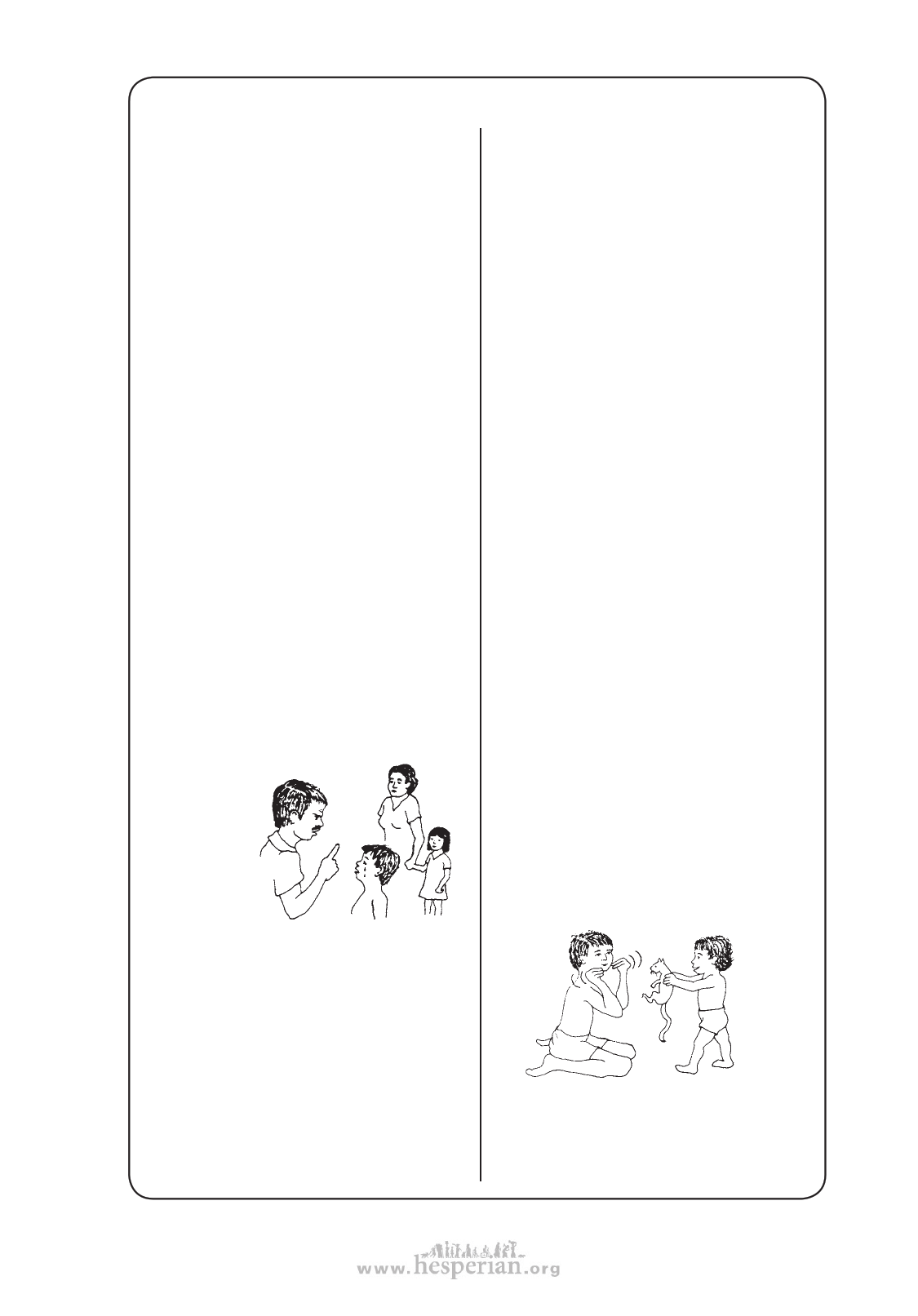
DEAFNESS 259
TONIO
Although Tonio was born with a severe hearing
loss, his parents did not realize this until he was 4
years old. For a long time, they thought he was just
slow. Or stubborn.
Until he was one year old, Tonio seemed to be
doing fairly well. He began to walk and play with
things. Then his sister, Lota, was born. Lota smiled
and laughed more than Tonio when their mother
talked or sang to her. So their mother talked and sang
to Lota more.
By the time Lota was 1, she was already beginning
to say a few words. Tonio had not yet begun to speak.
“Are you sure he can hear?” a neighbor asked one
day. “Oh yes,” said his mother. She called his name
loudly, and Tonio turned his head.
When he was 3, Tonio could only say 2 or 3
words. Lota, at age 2, now spoke more than 200
words. She asked for things, sang simple songs,
and played happily with other children. Tonio was
more moody. Mostly he played by himself. When
he played with other children it often ended in
fighting—or crying.
Lota behaved better than Tonio. Usually, when
her mother told her not to do something and why,
she understood and obeyed. Often, to make Tonio
obey, his mother would slap him.
One time in the village market Lota asked for a
banana and her mother bought her one. A moment
later, Tonio quietly picked up a mango and began to
eat it. His mother slapped him. Tonio threw himself
on the ground and began to kick and scream.
When Tonio’s father heard what had happened
in the market, he looked angrily at Tonio and said,
“When will you learn to ask for
things? You’re 4 years
old and still don’t
even try to talk.
Are you stupid,
or just lazy?”
SANDRA
When Sandra was 10 months old, her
7-year-old brother, Lino, learned about testing
for deafness as part of the CHILD-to-child
program at school (see p. 450). So he tested
his baby sister. When he stood behind her
and called her name or rang a bell, she did not
turn or even blink. Only when he hit a pan hard
did she show surprise. He told his parents
he thought Sandra did not hear well. They
took Sandra to a small rehabilitation center. A
worker there tested Sandra and agreed she
had a severe hearing loss.
The village worker explained what the family
could do to help Sandra develop and learn to
communicate. He gave them many drawings of
hands held to make ‘signs’ for common words.
“Every time you speak, make ‘signs’ with your
hands to show what you mean. Include all the
signs and gestures that people already use in
your village. Teach all the children to use them
too. Make a game out of it. At first Sandra won’t
understand. But she’ll watch and learn. In time
she’ll begin to use signs herself.”
“If she gets used to signs, won’t that keep her
from learning to speak?” asked her father.
“No,” said the worker. “Not if you always
speak the words at the same time. The signs
will help her understand the words, and she
may even learn to speak earlier. But it takes
years to learn to speak with ‘lip reading’. First,
she needs to learn to use signs to say what she
wants and to develop her mind.”
Sandra’s family began using signs as they
spoke to each other. Months passed, and still
Sandra did not begin to speak or to make signs.
But now she was watching more closely.
By age 3, Sandra began to make signs. By
age 4 she could say and understand many
things with signs—even lip read a few words,
like ‘Yes’, ‘No’, and ‘Lino’. By age 5 she had
only learned to ‘lip read’ a few words. But with
signs she could say over 1000 words and many
simple sentences.
Tonio just looked at his father. Tears rolled down
his cheeks. He could not understand what his father
said. But he understood the angry look. His father
softened and took him in his arms.
Tonio’s behavior got worse and worse. At age 4
his mother took him to a health worker, who tested
Tonio and found that he was deaf.
Now Tonio’s parents are trying to make up for
lost time. They try to speak to him clearly and
slowly, in good light, and to use some signs and
gestures with their hands to help him understand.
Tonio seems a little happier and speaks a few more
words. But he still has a lot of trouble saying what
he wants.
Sandra was happy and active. She liked to
color pictures and play guessing games. Lino
began to teach her how to draw letters. One
day she asked Lino when she could go to
school.
disabled village children